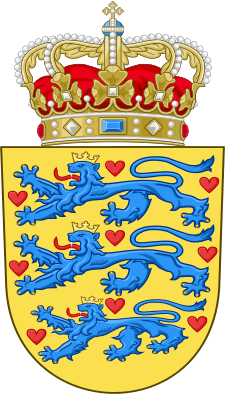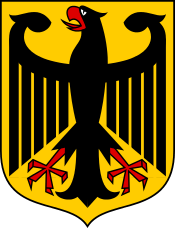Denmark–Germany relations
 |
|
Denmark |
Germany |
|---|---|
Denmark–Germany relations are the foreign relations between Denmark and Germany. Denmark has an embassy in Berlin and three General Consulates in Flensburg, Hamburg and Munich.[1] Both countries are full members of NATO and of the European Union. The border between the countries, which lies in the Schleswig region, has changed several times through history, the present border was determined by referendums in 1920. The Danish-German border area has been named as a positive example for other border regions.[2] Substantial minority populations live on both sides of the border, and cross-border cooperation activities are frequently initiated.[3][4]
History
First Schleswig War
The First Schleswig War was the first round of military conflict in southern Denmark and northern Germany rooted in the Schleswig-Holstein Question, contesting the issue of who should control the Duchies of Schleswig and Holstein. The war, which lasted from 1848–1851, also involved troops from Prussia and Sweden. Ultimately, the war resulted in a Danish victory. A second conflict, the Second Schleswig War, erupted in 1864.
Second Schleswig War
The Second Schleswig War was the second military conflict as a result of the Schleswig-Holstein Question. It began on 1 February 1864, when Prussian forces crossed the border into Schleswig.
Denmark fought Prussia and Austria. Like the First Schleswig War (1848–51), it was fought for control of the duchies because of succession disputes concerning the duchies of Holstein and Lauenburg when the Danish king died without an heir acceptable to the German Confederation. Decisive controversy arose due to the passing of the November Constitution, which integrated the Duchy of Schleswig into the Danish kingdom in violation of the London Protocol.
The war ended on 30 October 1864, when the Treaty of Vienna caused Denmark's cession of the Duchies of Schleswig, Holstein, and Saxe-Lauenburg to Prussia and Austria. The war resulted in a German victory.
World War II
Operation Weserübung was the code name for Germany's assault on Denmark and Norway during the Second World War and the opening operation of the Norwegian Campaign. The name comes from the German for Operation Weser-Exercise, the Weser being a German river.
In the early morning of 9 April 1940, Germany invaded Denmark and Norway, ostensibly as a preventive manoeuvre against a planned, and openly discussed, Franco-British occupation of both these countries. After the invasions, envoys of the Germans informed the governments of Denmark and Norway that the Wehrmacht had come to protect the countries' neutrality against Franco-British aggression. Significant differences in geography, location and climate between the two countries, however, made the actual military operations very dissimilar.
Strategically, Denmark's importance to Germany was as a staging area for operations in Norway, and of course as a border nation to Germany which would have to be controlled in some way. Given Denmark's position in relation to the Baltic Sea the country was also important for the control of naval and shipping access to major German and Soviet harbours.
Small and relatively flat, the country was ideal territory for German army operations, and Denmark's small army had little hope. Nevertheless, in the early morning hours, a few Danish troops engaged the German army, suffering losses of 16 dead and 20 wounded. The Germans lost an unknown number of casualties, with 12 armoured cars and several motorcycles and cars destroyed. Four German tanks were damaged. One German bomber was also damaged.[5] Two German soldiers were temporarily captured by the Danes during the brief fighting.[6]
At 04:00 on 9 April 1940, the German ambassador to Denmark, Renthe-Fink, called the Danish Foreign Minister Munch and requested a meeting with him. When the two men met 20 minutes later, Renthe-Fink declared that German troops were at that moment moving in to occupy Denmark to protect the country from Franco-British attack. The German ambassador demanded that Danish resistance cease immediately and contact be made between Danish authorities and the German armed forces. If the demands were not met, the Luftwaffe would bomb the capital, Copenhagen.[6]
.jpg)
As the German demands were communicated, the first German advances had already been made, with forces landing by ferry in Gedser at 04:15 and moving north. German Fallschirmjäger units had made unopposed landings and taken two airfields at Aalborg, the Storstrøm Bridge as well as the fortress of Masnedø.[6]
At 04:20 local time, 1,000 German infantrymen landed in Copenhagen harbour from the minelayer Hansestadt Danzig, quickly capturing the Danish garrison at the Citadel without encountering resistance. From the harbour, the Germans moved towards Amalienborg Palace to capture the Danish royal family. By the time the invasion forces arrived at the king's residence, the King's Royal Guard had been alerted and other reinforcements were on their way to the palace. The first German attack on Amalienborg was repulsed, giving Christian X and his ministers time to confer with the Danish Army chief General Prior. As the discussions were ongoing, several formations of Heinkel He 111 and Dornier Do 17 bombers roared over the city dropping the OPROP! leaflets. Faced with the explicit threat of the Luftwaffe bombing the civilian population of Copenhagen, and only General Prior in favour of continuing to fight, the King Christian X and the entire Danish government capitulated at 08:34 in exchange for retaining political independence in domestic matters.[6]
At 05:45, two squadrons of German Bf 110s attacked Værløse airfield on Zealand and wiped out the Danish Army Air Service by strafing. Despite Danish anti-aircraft fire, the German fighters destroyed 11 Danish aircraft and seriously damaged another 14.[6]
The invasion of Denmark lasted less than six hours and was the shortest military campaign conducted by the Germans during the war. The rapid Danish capitulation resulted in the uniquely lenient Occupation of Denmark, particularly until the summer of 1943, and in postponing the arrest and deportation of Danish Jews until nearly all of them were warned and on their way to refuge in Sweden.[7] In the end, 477 Danish Jews were deported, and 70 of them lost their lives, out of a pre-war total of Jews and half-Jews at a little over 8,000.[8]
Contemporary
Both Germany and Denmark are members of the European Union and NATO. Denmark has an Embassy in Berlin, as well as a Consulate General in Flensburg[9] and one in Hamburg.[10] Germany maintains an Embassy in Copenhagen as well as a network of honorary consulates around Denmark. Additionally, the Danish Ministry of Education (Undervisningsministeret) cooperated with the Bundes state of Baden-Württemberg's ministry of education, Kultusministerium, to develop and carry out an exchange programme between gymnasium students in both countries.[11] The official name of the programme is "Deutsch-Dänisches grenzenübergreifendes Schüleraustauschprogramm für die Entwicklung und den Beibehalt, essentieller kultureller Verständigung und prägenden Erfahrungen". The first exchange was officially carried out in April 2016 in the city of Mosbach, Baden-Württemberg. The second official exchange took place in Odense, Denmark, in May, followed by a third, but not final, succesful visit in August 2016. Even though the programme is officially over, plans have been made for a comeback before the end of 2016. [12]
References
- ↑ Danish embassy in Berlin (in Danish and German only)
- ↑ The European Centre for Minority Issues (ECMI): "German-Danish Border Region". Retrieved 2014-05-03.
- ↑ Press releases from the European Commission: "Denmark (Syddanmark)-Germany (Schleswig-KERN) Cross-border Operational Programme "Syddanmark-Schleswig-K.E.R.N" 2007-2013". Retrieved 2014-05-03.
- ↑ Femern A/S - newsletter no. 25: "DialogForumNorden promotes cross-border cooperation". Retrieved 2014-05-03.
- ↑ Hooton 2007, p. 31.
- 1 2 3 4 5 Gert Laursen: The German occupation of Denmark
- ↑ The Danish Jewish Museum: The operation against the Danish Jews in October 1943
- ↑ Holocaust Education & Archive Research Team
- ↑ Generalkonsulatet i Flensburg, Ministry of Foreign Affairs (Denmark)
- ↑ Generalkonsulat i Hamborg, Ministry of Foreign Affairs (Denmark)
- ↑
- ↑ Denmark German missions, German Foreign Office
External links
- Danish general consulate in Flensburg (in Danish and German only)
- Danish general consulate in Hamburg (in Danish and German only)
- Danish general consulate in Munich (in Danish and German only)
- German Federal Foreign Office about the relations with Denmark
- German embassy in Copenhagen (in Danish and German only)
- Bonn-Copenhagen Declarations

